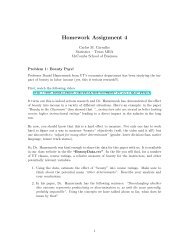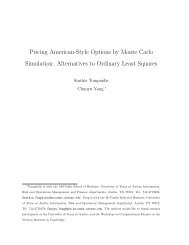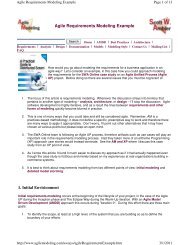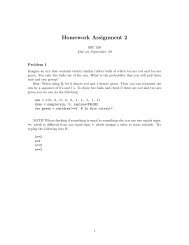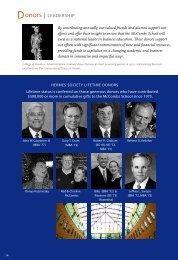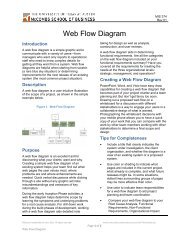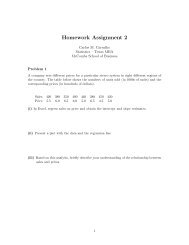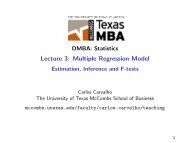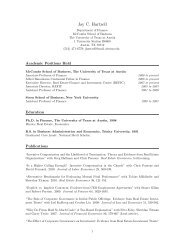Homework Assignment 4 - McCombs School of Business
Homework Assignment 4 - McCombs School of Business
Homework Assignment 4 - McCombs School of Business
- No tags were found...
You also want an ePaper? Increase the reach of your titles
YUMPU automatically turns print PDFs into web optimized ePapers that Google loves.
274 the journal <strong>of</strong> law and economics<br />
TABLE 4<br />
Reduction in Crime on High-Alert Days: Concentration on the National Mall<br />
Coefficient<br />
(Robust)<br />
High Alert # District 1<br />
2.621**<br />
(.044)<br />
High Alert # Other Districts .571<br />
(.455)<br />
Log(midday ridership) 2.477*<br />
(.364)<br />
Constant<br />
11.058**<br />
(4.211)<br />
Coefficient<br />
(HAC)<br />
2.621*<br />
(1.19)<br />
.571<br />
(.366)<br />
2.477**<br />
(.522)<br />
11.058<br />
(5.87)<br />
Coefficient<br />
(Clustered by Alert<br />
Status and Week)<br />
2.621*<br />
(1.225)<br />
.571<br />
(.364)<br />
2.477**<br />
(.527)<br />
11.058 <br />
(5.923)<br />
Note.—The dependent variable is daily crime totals by district. Standard errors (in parentheses) are<br />
clustered by district. All regressions contain day-<strong>of</strong>-the-week fixed effects and district fixed effects. The<br />
2<br />
number <strong>of</strong> observations is 3,542. R p .28. HAC p heteroskedastic autocorrelation consistent.<br />
<br />
Significantly different from zero at the 10 percent level.<br />
* Significantly different from zero at the 5 percent level.<br />
** Significantly different from zero at the 1 percent level.<br />
Figure 2: The dependent variable is the daily total number <strong>of</strong> crimes in D.C. District 1<br />
refers to a dummy variable associated with crime incidents in the first police district area.<br />
This table present the estimated coefficients and their standard errors in parenthesis.* refers<br />
to a significant coeficient at the 5% level, ** at the 1% level.<br />
an <strong>of</strong>ficial news release from February 27, 2003. 17 Un<strong>of</strong>ficially, we were told<br />
that during heightened alert periods, the police department switches from<br />
three 8-hour shifts a day to two 12-hour shifts, thus increasing the effective<br />
police presence by 50 percent. 18 Despite several requests, however, the D.C.<br />
police would neither confirm nor deny this exact procedure. Nevertheless, if<br />
we take 50 percent as an approximate figure, then we estimate an elasticity<br />
<strong>of</strong> crime with respect to police presence <strong>of</strong> 15 percent/50 percent p .3.<br />
As it turns out, this is exactly the figure estimated by Thomas Marvell and<br />
Carlisle Moody and is also consistent with a range <strong>of</strong> elasticities on different<br />
crimes from approximately .2 to .9 analyzed by Levitt, Corman and Mocan,<br />
and Di Tella and Schargrodsky. 19<br />
Crime may come in waves; we control for some <strong>of</strong> this using day-<strong>of</strong>-theweek<br />
effects, but there may be other sources <strong>of</strong> dependence that result in<br />
serial correlation and thus downwardly biased standard errors. 20 To address<br />
this problem, the second column <strong>of</strong> Table 4 reruns the regression using hetero-<br />
17<br />
See Metropolitan Police Department, supra note 10.<br />
18<br />
With three shifts <strong>of</strong> x police, there are 3x police on the street per day; with two shifts,<br />
there are 2y, assuming that 2y p 3x (the same number 4<strong>of</strong><br />
police are allocated over the day);<br />
then y p 3/2x, an increase <strong>of</strong> 50 percent.<br />
19<br />
Marvell & Moody, supra note 4; Levitt, Reply, supra note 4; Corman & Mocan, supra<br />
note 4; Di Tella & Schargrodsky, supra note 7.<br />
20



